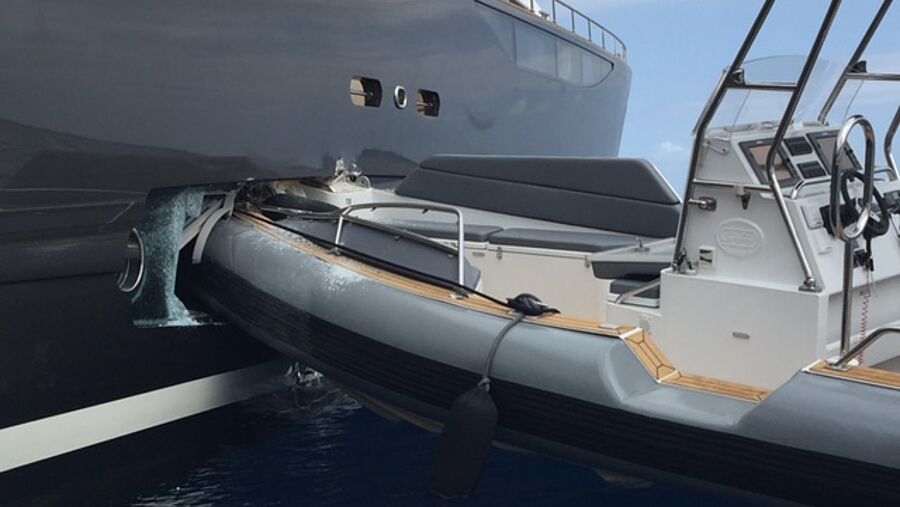Uncontrolled Impact
A €1.5 million claim highlights the consequences of a missing killcord—and why even the simplest safety procedures should never be overlooked.
In summer 2016, a 37.8-metre yacht was cruising the island of Formentera, the smallest of Spain’s Balearic Islands, and a popular summer yachting destination, renowned for its low-key bohemian vibe and Caribbean-style beaches with buttercream sand and crystalline waters. The motor yacht had recently been insured by Pantaenius.

As the yacht sat at anchor in a crowded bay dotted with pleasure boats, a sudden bang jolted it unexpectedly. Rushing to the point of impact, the crew saw what had caused it: a tender had collided with the yacht, punching a giant hole in a wide glass window in the starboard midship. The impact also damaged the hull around the opening.
Both the tender captain and a crew member accompanying him had been thrown from the vessel before the impact. Without anyone at the controls, the vessel had reportedly spun on itself for 15 minutes, before crashing into the yacht. Fortunately, there were only two crew and no guests onboard at the time, and no one was injured.
“The collision was caused by the negligence of the tender’s skipper,” explains Pantanenius’ Monaco-based superyacht claims manager, Manon Belloeil. “He was operating the tender at high speed without having properly secured the killcord to his wrist.”
A Killcord Would Have Helped
Had the skipper followed necessary safety procedures and had the killcord clipped to his wrist, as he fell overboard the engine power would have been cut instantly, preventing the tender from running uncontrolled. A simple device with huge safety consequences, a lack of vigilance and a false sense of security on the tender meant, on this occasion, its use was overlooked.
The yacht manager sent a claim notification to Pantaenius within moments of the incident.
The total cost of the claim amounted to approximately €1.5 million and was fully covered by the Protection & Indemnity (P&I) insurance of the tender’s mothership, as the incident was deemed an accident rather than an intentional act. P&I covers the third-party liability risks associated with owning and operating a yacht (P&I does not provide cover for the physical damage to the yacht itself, that falls under hull insurance).
The extent of repairs required ended the motor yacht's summer season, with charters already booked having to be cancelled. The payout covered repairs, accommodation for guests and crew and loss of charter income.
“The key lesson here is to wear a killcord,” continues Belloeil. “If the skipper is thrown overboard, it's safer to simply cut the engine. Even crew members find it difficult to reach the controls at that speed when there’s no killcord at play.”
Rare but Tragic
Belloeil recalls another incident from a decade ago, with a tragic outcome. “Three passengers, the skipper and two journalists, were on a tender during a demonstration during a boat show,” she says. “The captain, who was not wearing a killcord, was ejected along with one journalist. The remaining journalist jumped into the water. The boat, spinning on itself, ran over and killed that journalist.”
Such incidents remain quite rare, fortunately, and can be easily avoided — “by following proper procedures and adopting the right reflexes,” Belloeil adds.
Since the 2016 incident, digital killcords that can help prevent or limit these accidents have also flooded the market. When a skipper wearing a digital killcord bracelet is ejected from the tender, the movement out of range triggers the bracelet to cut the engine instantly.
Yet, as this incident shows, even the most advanced systems are only as effective as the habits and awareness of those using them.
For yacht owners, crew, and guests alike, the lesson is clear: vigilance, training and respect for even the simplest safety devices can mean the difference between a close call and catastrophe.